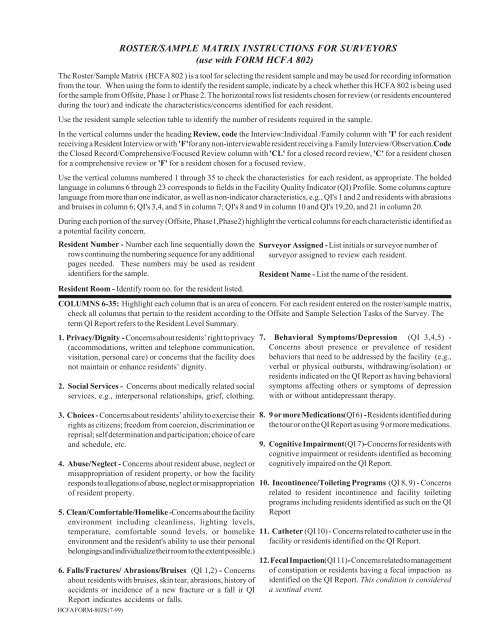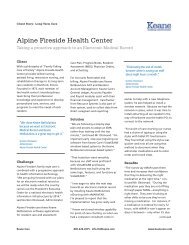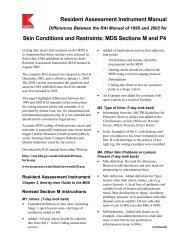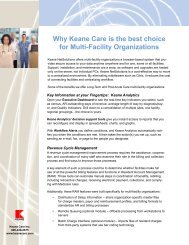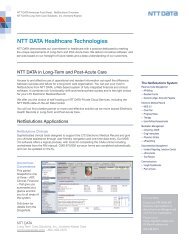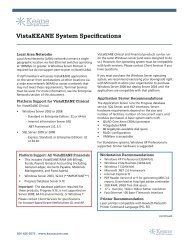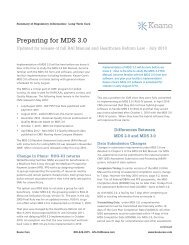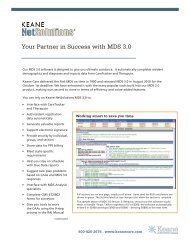ROSTER/SAMPLE MATRIX INSTRUCTIONS FOR SURVEYORS ...
ROSTER/SAMPLE MATRIX INSTRUCTIONS FOR SURVEYORS ...
ROSTER/SAMPLE MATRIX INSTRUCTIONS FOR SURVEYORS ...
You also want an ePaper? Increase the reach of your titles
YUMPU automatically turns print PDFs into web optimized ePapers that Google loves.
<strong>ROSTER</strong>/<strong>SAMPLE</strong> <strong>MATRIX</strong> <strong>INSTRUCTIONS</strong> <strong>FOR</strong> <strong>SURVEYORS</strong><br />
(use with <strong>FOR</strong>M HCFA 802)<br />
The Roster/Sample Matrix (HCFA 802 ) is a tool for selecting the resident sample and may be used for recording information<br />
from the tour. When using the form to identify the resident sample, indicate by a check whether this HCFA 802 is being used<br />
for the sample from Offsite, Phase 1 or Phase 2. The horizontal rows list residents chosen for review (or residents encountered<br />
during the tour) and indicate the characteristics/concerns identified for each resident.<br />
Use the resident sample selection table to identify the number of residents required in the sample.<br />
In the vertical columns under the heading Review, code the Interview:Individual /Family column with 'I' for each resident<br />
receiving a Resident Interview or with 'F' for any non-interviewable resident receiving a Family Interview/Observation. Code<br />
the Closed Record/Comprehensive/Focused Review column with 'CL' for a closed record review, 'C' for a resident chosen<br />
for a comprehensive review or 'F' for a resident chosen for a focused review.<br />
Use the vertical columns numbered 1 through 35 to check the characteristics for each resident, as appropriate. The bolded<br />
language in columns 6 through 23 corresponds to fields in the Facility Quality Indicator (QI) Profile. Some columns capture<br />
language from more than one indicator, as well as non-indicator characteristics, e.g., QI's 1 and 2 and residents with abrasions<br />
and bruises in column 6; QI's 3,4, and 5 in column 7; QI's 8 and 9 in column 10 and QI's 19,20, and 21 in column 20.<br />
During each portion of the survey (Offsite, Phase1,Phase2) highlight the vertical columns for each characteristic identified as<br />
a potential facility concern.<br />
Resident Number - Number each line sequentially down the<br />
rows continuing the numbering sequence for any additional<br />
pages needed. These numbers may be used as resident<br />
identifiers for the sample.<br />
Resident Room - Identify room no. for the resident listed.<br />
COLUMNS 6-35: Highlight each column that is an area of concern. For each resident entered on the roster/sample matrix,<br />
check all columns that pertain to the resident according to the Offsite and Sample Selection Tasks of the Survey. The<br />
term QI Report refers to the Resident Level Summary.<br />
1. Privacy/Dignity - Concerns about residents’ right to privacy<br />
(accommodations, written and telephone communication,<br />
visitation, personal care) or concerns that the facility does<br />
not maintain or enhance residents’ dignity.<br />
2. Social Services - Concerns about medically related social<br />
services, e.g., interpersonal relationships, grief, clothing.<br />
3. Choices - Concerns about residents’ ability to exercise their<br />
rights as citizens; freedom from coercion, discrimination or<br />
reprisal; self determination and participation; choice of care<br />
and schedule, etc.<br />
4. Abuse/Neglect - Concerns about resident abuse, neglect or<br />
misappropriation of resident property, or how the facility<br />
responds to allegations of abuse, neglect or misappropriation<br />
of resident property.<br />
5. Clean/Comfortable/Homelike - Concerns about the facility<br />
environment including cleanliness, lighting levels,<br />
temperature, comfortable sound levels, or homelike<br />
environment and the resident's ability to use their personal<br />
belongings and individualize their room to the extent possible.)<br />
6. Falls/Fractures/ Abrasions/Bruises (QI 1,2) - Concerns<br />
about residents with bruises, skin tear, abrasions, history of<br />
accidents or incidence of a new fracture or a fall ir QI<br />
Report indicates accidents or falls.<br />
HCFA <strong>FOR</strong>M-802S (7-99)<br />
Surveyor Assigned - List initials or surveyor number of<br />
surveyor assigned to review each resident.<br />
Resident Name - List the name of the resident.<br />
7. Behavioral Symptoms/Depression (QI 3,4,5) -<br />
Concerns about presence or prevalence of resident<br />
behaviors that need to be addressed by the facility (e.g.,<br />
verbal or physical outbursts, withdrawing/isolation) or<br />
residents indicated on the QI Report as having behavioral<br />
symptoms affecting others or symptoms of depression<br />
with or without antidepressant therapy.<br />
8. 9 or more Medications (QI 6) - Residents identified during<br />
the tour or on the QI Report as using 9 or more medications.<br />
9. Cognitive Impairment (QI 7) - Concerns for residents with<br />
cognitive impairment or residents identified as becoming<br />
cognitively impaired on the QI Report.<br />
10. Incontinence/Toileting Programs (QI 8, 9) - Concerns<br />
related to resident incontinence and facility toileting<br />
programs including residents identified as such on the QI<br />
Report<br />
11. Catheter (QI 10) - Concerns related to catheter use in the<br />
facility or residents identified on the QI Report.<br />
12. Fecal Impaction (QI 11) - Concerns related to management<br />
of constipation or residents having a fecal impaction as<br />
identified on the QI Report. This condition is considered<br />
a sentinal event.
Roster /Sample Matrix Instructions for Surveyors<br />
13. UTI/Infection Control/Antibiotics (QI 12) - Concerns<br />
about presence or prevalence of resident infections, facility<br />
infection control practices, residents receiving antibiotics,<br />
or residents identified as having a UTI on the QI Report.<br />
14. Weight Change/Nutrition/Swallowing/Dentures (QI 13) -<br />
Concerns about residents with nutritional needs, chewing or<br />
swallowing problems that may affect intake (including the<br />
use of dentures), experiencing significant or chronic insidious<br />
unintended weight change, being on a restorative dining<br />
program or residents identified on the QI Report as having<br />
a weight loss.<br />
15. Tube Feedings (QI 14) - Concerns related to residents<br />
having a feeding tube or identified on the QI Report as having<br />
a feeding tube.<br />
16. Dehydration (QI 15) - Concerns about residents who show<br />
signs or symptoms or have risk factors for dehydration or<br />
who are identified on the QI Report as having dehydration.<br />
This condition is considered a sentinal event.<br />
17. Bedfast Residents (QI 16)- Concerns about residents<br />
identified on the QI Report or observed to be bedfast.<br />
18. ADL Decline/Concern (QI 17) - Concern that resident<br />
receives appropriate treatment and services to maintain or<br />
improve ability or concerns about residents identified on the<br />
QI Report as having an ADL decline.<br />
19. ROM/Contractures/Positioning (QI18) - Concerns about<br />
the occurrence, prevention or treatment of contractures.<br />
Concerns with staff provision or lack of provision of splints,<br />
ROM, the appropriate positioning of residents or residents<br />
identified on the QI Report as having a decline in ROM.<br />
20. Psychoactive Meds (QI 19,20,21) - Concerns about the use<br />
of psychoactive medications or residents identified on QI<br />
Report with antipsychotic use in the absence of psychotic<br />
or related conditions or use of antianxiety or hypnotic<br />
medications.<br />
24. Pain/Comfort - Concerns about timely assessment and<br />
intervention with residents needing pain or comfort<br />
measures or who are on a pain management program.<br />
25. Language/Communication - Concerns about the facility<br />
assisting those residents with communication difficulties<br />
to communicate at their highest practicable level or<br />
residents identified as speaking other than the dominant<br />
language of the facility.<br />
26. Vision/Hearing/Devices - Concerns about the facility<br />
assisting those residents with visual or hearing impairments<br />
to function at their highest practicable level including<br />
those residents who have glasses or hearing aids.<br />
27. Specialized Rehab - Concerns about the facility's provision<br />
or lack of provision of Specialized Rehabilitative Services<br />
including:<br />
• Physical therapy<br />
• Speech/language pathology<br />
• Occupational therapy<br />
• Health rehabilitative services for MI/MR<br />
28. Assistive Devices - Concerns about the need for, absence<br />
of or use of special devices to assist residents in eating<br />
(e.g. tables, utensils, hand splints, etc.) or concerns about<br />
any other assistive devices. (e.g. canes, crutches, etc.)<br />
29. Hospice - Concerns for residents who have elected the<br />
hospice benefit, whether the resident lives in the facility<br />
or is temporarily receiving inpatient services or respite<br />
care.<br />
30. Dialysis - Concern about care and coordination of<br />
services for residents receiving hemo or peritoneal dialysis<br />
either in the facility or at another site.<br />
31. Oxygen/ Respiratory Care - Concerns about care provided<br />
to residents with tracheotomies or ventilators, residents<br />
needing suctioning, and residents receiving oxygen, etc.<br />
21. Physical Restraints (QI 22) - Concerns about the use of<br />
physical restraints or residents identified on the QI Report<br />
as physically restrained daily (excluding side rails).<br />
22. Activities (QI 23) - Concerns about activities meeting<br />
cultural needs, interests, preferences, etc. of residents or<br />
residents identified on the QI Report as having little or no<br />
activity.<br />
23. Pressure Sores/Ulcers (QI 24)- Concerns about the<br />
occurrence, assessment, prevention or treatment of pressure<br />
ulcers or other necessary skin care or residents identified on<br />
the QI Report as having stage 1-4 pressure ulcers. Residents<br />
who flag at low risk for this QI are considered to have a<br />
sentinal event.<br />
HCFA <strong>FOR</strong>M-802S (7-99)<br />
32. Adm./Transfer/Discharge - Concerns about care/tx for<br />
residents recently admitted. Concerns about resident<br />
preparation and procedures for transfer or discharge.<br />
33. MR/MI (Non Dementia) - Concerns related to the care and<br />
treatment of residents with mental retardation or mental<br />
illness.<br />
34-35. Note any other concerns, e.g. residents who are<br />
comatose or have special care areas (e.g. prosthesis,<br />
side rails, ostomy, injection, special foot care and IV’s,<br />
including total parenteral nutrition) that may be of<br />
concern in the column. If during the Offsite prep,<br />
concerns arise about the accuracy of the MDS, enter<br />
MDS accuracy as a concern.


